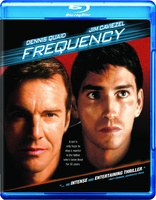Frequency Blu-ray Movie
HomeFrequency Blu-ray Movie 
Warner Bros. | 2000 | 119 min | Rated PG-13 | Jul 10, 2012Movie rating
7.5 | / 10 |
Blu-ray rating
| Users | 4.2 | |
| Reviewer | 4.5 | |
| Overall | 4.4 |
Overview
Frequency (2000)
A tale of time travel in which a father and a son reach out to one another across a thirty-year gap to prevent a terrible crime.
Starring: Dennis Quaid, Jim Caviezel, Shawn Doyle, Elizabeth Mitchell, Andre BraugherDirector: Gregory Hoblit
| Thriller | Uncertain |
| Supernatural | Uncertain |
| Sci-Fi | Uncertain |
| Crime | Uncertain |
| Drama | Uncertain |
Specifications
Video
Video codec: MPEG-4 AVC
Video resolution: 1080p
Aspect ratio: 2.35:1
Original aspect ratio: 2.39:1
Audio
English: DTS-HD Master Audio 7.1 (48kHz, 24-bit)
Spanish: Dolby Digital 2.0
Portuguese: Dolby Digital 2.0
Czech: Dolby Digital 2.0
Music: Dolby Digital 5.1
Subtitles
English SDH, Portuguese, Spanish, Czech
Discs
50GB Blu-ray Disc
Single disc (1 BD)
Playback
Region free
Review
Rating summary
| Movie | 4.5 | |
| Video | 4.5 | |
| Audio | 4.5 | |
| Extras | 4.0 | |
| Overall | 4.5 |
Frequency Blu-ray Movie Review
The Aurora Borealis Flux Capacitor
Reviewed by Michael Reuben July 15, 2012The achievement of Frequency is to knit an array of disparate strands into one coherent film not quite like any other you've seen. It includes a sci-fi story about time displacement (but not time travel), a thriller, a police procedural, the dangerous life of a firefighter, a baseball movie, a tale of a father's and son's devotion and a mother's love—and everything fits. The director of this uniquely satisfying two hours was Gregory Hoblit, whose years helming multi-threaded narratives on TV's Hill Street Blues and NYPD Blue proved to be the ideal preparation for Frequency. A different director might have tried to simplify Toby Emmerich's script, but Hoblit kept everything while trying to make it more visceral, accessible and compelling. Many of Hoblit's techniques work so well that they're invisible to the audience. Frequency's central scenes, both emotionally and narratively, are the conversations between a father and his adult son across a thirty-year time gap caused by a freak of solar activity. The intensity of the emotional connection in these scenes is just as critical as the information being passed back and forth causing ripples (and more) in the timeline. The two characters don't share the screen, and another director might have filmed them separately, but Hoblit put actors Dennis Quaid and Jim Caviezel in adjoining rooms connected by microphones with two cameras on each actor, so that they performed these exchanges in real time with each aware that the other was nearby. The result electrifies the performances and galvanizes the film.
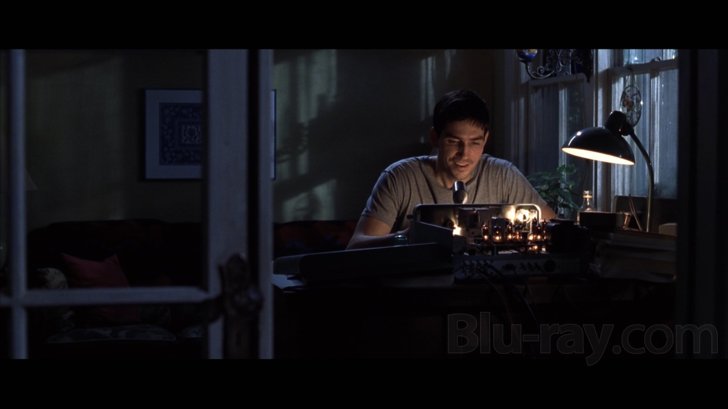
In 1969, unusual sunspot activity has caused the aurora borealis to appear over Queens (where, in reality, it has never been seen). Frank Sullivan (Quaid), a New York fireman and die-hard Mets fan, drags along a rookie (Jordan Bridges) on a spectacular rescue involving a gasoline truck, then returns home to his wife, Jules (Elizabeth Mitchell), a nurse, and their son, Johnny (Daniel Henson), whom Frank calls "Little Chief". Johnny is playing with his best friend, Gordo (Stephen Joffe), and still trying to learn how to ride a bike without training wheels. The Sullivan household is a happy home, the kind where friends gather for a weekend barbecue while watching a Mets game. Frank Sullivan's best friend carries a badge from the "other" service; he's a cop named Satch DeLeon (Andre Braugher). In 1999, John, now fully grown (Caviezel), lives in the same house with his long-time girlfriend, Samantha (Melissa Errico)—except that Samantha is in the process of moving out. John has become a police detective working with Satch DeLeon. He has the haunted look of a man who hasn't settled in life, which may have to do with the fact that his father, Frank, died fighting a fire thirty years ago. On this particular evening, Gordo (now played by Noah Emmerich), who is still John's best friend and neighbor, stops by with his own young son, Gordy Jr. (Michael Cera, still a kid but instantly recognizable), and just happens to pull out Frank Sullivan's old ham radio. John and Gordo plug it in to show young Gordy how people used to communicate over long distances before the internet. The aurora borealis is shining brightly overhead, just as it was in 1969. Late that night, John picks up an oddly familiar voice broadcasting from another ham radio in Queens. In fact, it's the same radio thirty years earlier. It takes several conversations, and a few time-warping tricks such as John's recounting the play-by-play progress of a World Series game that hasn't yet happened for Frank, before the two men realize and accept who the other is, but then they can't stop talking. When John realizes he's talking to Frank just before the fire that claimed his life, he tells him everything he knows about it, and Frank survives after a stunning sequence that could have come from Backdraft. As any sci-fi fan can tell you, though, changing a timeline always has unforeseen consequences, frequently bad ones. One effect of Frank's survival is to prolong a serial killer case that was making headlines in 1969 but originally ended that year. Now the case continues for much longer, claiming many more victims and affecting the Sullivans directly. John, who somehow retains memories from both timelines, finds that he and Satch have been working the case for years. He tells Frank they have to "fix" what they've broken. Father and son trade information (and more) furiously between time periods, while the killer continues to elude them in both. Meanwhile, both the young and the old version of Satch grow increasingly suspicious of the Sullivans. It would be unfair to new viewers to reveal every twist and turn, except to say that Frank eventually has to tell Satch about his source, which leads to a memorable conversation between Satch and Jules, in which her husband's old friend tells the worried wife that her commonsensical husband claims to be talking to their son in the future. Under Hoblit's sure hand and the precision cutting of David Rosenbloom (a Hill Street veteran and Hoblit's usual editor), all of this winds toward a unique and satisfying conclusion that had theater audiences cheering, then choking up. Although Hoblit says in his commentary that he would still like to reshoot parts of the ending, he surrendered in the face of something that so obviously pleased the viewers.
Frequency Blu-ray Movie, Video Quality 
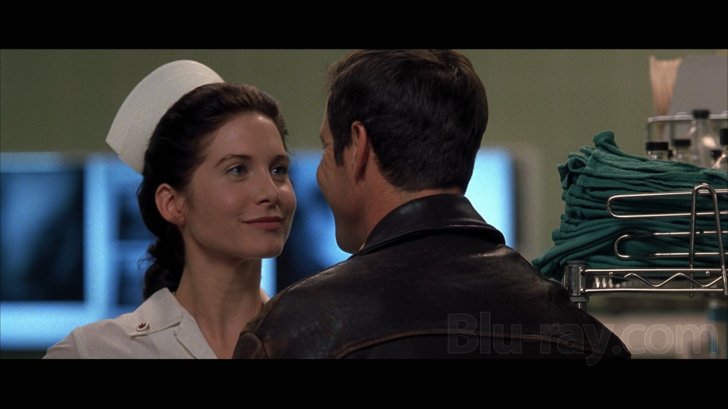
The Canadian cinematographer Alar Kivilo (The Blind Side, The Lookout) was the DP on Frequency, and the film is notable for the subtle intensity of its imagery, which Kivilo achieved through a combination of deep blacks and blues, sharp focus and subtle shifts between the color palettes of 1969 and 1999, and then again within 1999 as the activities of Frank and John Sullivan reshape history and the present. (Hoblit says on the commentary that, if he had it to do over again, he would make the shifts less subtle, but personally I'm glad he's forced to leave things as they are.) Warner/New Line's 1080p, AVC-encoded Blu-ray presents Kivilo's imagery to fine advantage, with solid black levels, exceptional detail in both dark and brightly lit portions of the frame, and colors that accurately contrast the warmer hues of Frank's convivial home in 1969 with the chillier tones of John's sad surroundings in 1999. A fine (very fine) pattern of natural grain is evident in the image, and it does not appear to have been reduced or stripped by digital processing, nor has sharpness been created artificially by digital means that would leave traces such as "ringing". This is a film-like image like the one audiences saw in theaters, and I did not detect any compression errors to interfere with the viewer's enjoyment.
Frequency Blu-ray Movie, Audio Quality 

Frequency's DTS-HD MA 7.1 track has an expansive and involving presence, whose power is immediately evident during the early sequence when Frank Sullivan rescues Con Ed workers trapped in an underground steam tunnel by an overturned gasoline tanker. The viewing room comes alive with the details of dripping water, boots on ladder rungs, halogen tools against metal, sparking cables and a hundred other details that add urgency and immediacy to the action on screen. The same kind of attention to sonic minutia is evident in the later scenes of the warehouse fire that is supposed to claim Frank's life but doesn't, and indeed in every other environment where the story takes its two protagonists, in both 1969 and 1999. Bass extension is deep and powerful but never overstated or bombastic. The dialogue is always clear, unless your ear happens to have trouble with the Queens accent carefully learned by the cast and vouched for as accurate on the commentary track by composer Michael Kamen, a native. Kamen's score, with its varied moods and quicksilver shifts in tone, sounds terrific and has been expertly blended with the film's sound mix so that it underlines the story's emotions without overwhelming them. The pop songs sprinkled throughout the soundtrack, including Carly Simon's special rendition of "Take Me Out to the Ballgame" and Garth Brooks's original composition (with Jenny Yates), "When You Come Back to Me", which plays over the closing titles, sound equally good.
Frequency Blu-ray Movie, Special Features and Extras 
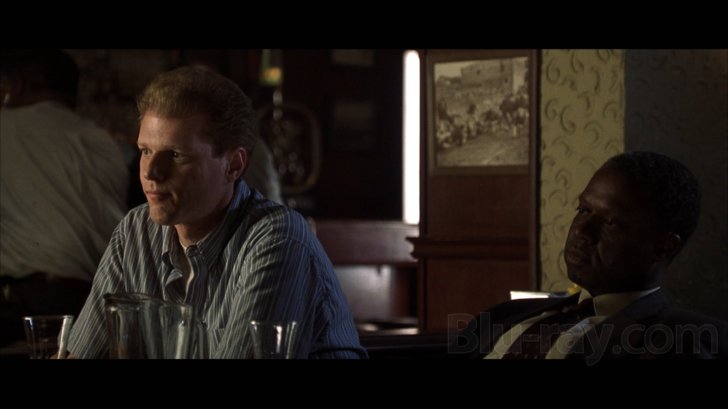
The extras have been ported over from the 2000 New Line "Platinum Series" DVD. Omitted are the following: a "fact and trivia" track; cast and crew bios; a promo for the Sierra Studios game Ground Control; and various DVD-ROM features, including the film's script synched with the film, the original website and promotional items for what was then the upcoming Lord of the Rings trilogy. In addition, the "solar galleries" had an option to be played simultaneously as multiple angles, and the five-part documentary had a "play all" function, which the Blu-ray lacks.
- Commentary with Director Gregory Hoblit: Hoblit notes at the end of the commentary that he typically doesn't rewatch his movies after the premiere and will probably never watch Frequency again, but that he would keep more of it than he would redo, which, one suspects, is as much as he's ever satisfied. His commentary contains numerous insights into the evolution of the script, the casting process and especially the ending of the film, which Hoblit wanted to reshoot, because he felt that the existing ending is inconsistent with the logic of timeline changes previously established by the plot; the overwhelmingly positive response of preview audiences to the existing ending forced him to scrap his proposal. Another area where Hoblit provides important insight is the difference between shooting for TV and shooting for feature films.
- Commentary with Writer Toby Emmerich and Actor Noah Emmerich: The two brothers poke fun at each other almost continuously until Noah has to leave for a prior appointment about 90 minutes into the film. Toby provides most of the useful information, and as the writer he has a detailed recollection of what changed between his original script and the final film.
- Isolated Music Track with Commentary by Composer Michael Kamen: Michael Kamen's death of a heart attack at age 55 in 2003 (just three years after the release of Frequency) was a huge loss to the world of both music and film. Hoblit says in his commentary that he asked Kamen to score Frequency because the film needed a composer who was equally adept at writing for action, emotional drama, suspense and science fiction. Between the musical passages on this track, Kamen discusses both his work on Frequency and his career in general, which included scoring The Wall for Pink Floyd, writing a guitar concerto for Eric Clapton and creating orchestral arrangements for Metalica. Kamen's stories about the legendary heavy metal band are the single best part of the track.
- The Science & Technology Behind Frequency (SD; 1.78, enhanced): This five-part documentary covers specific topics relevant to the film, only the last of which specifically involves the craft of film-making. Most of the interviewees come from outside the movie business: astronomy consultants, ham radio operators, physicists and firefighters. Special effects supervisor Bill Westenhofer is interviewed extensively for the final section, and comments are included here and there from Caviezel, Quaid and Noah and Toby Emmerich.
- Solar Science (6:48)
- Ham Radios (8:37)
- Time Travel & Theoretical Physics (8:36)
- Fighting Fires (7:54)
- Creating Natural Phenomena for Film (6:04)
- Solar Galleries (SD; 2.35:1, enhanced; 0:31 each): Four versions of the opening animation depicting solar flares.
- Rough 3-D Animation
- Animation with Lighting
- Complex Animation
- Final Film
- Deleted Scenes (SD; 2.35:1; 5.37): All four scenes are interesting, but none add anything new. Two are extended versions of existing scenes (the adult John giving the child Gordo a stock tip; a confrontation between Frank and the villain). The other two are a charming but unnecessary moment between Frank and Jules Sullivan and a cameo by screenwriter Toby Emmerich as a cop in Satch's precinct.
- Theatrical Trailer (SD; 1.85:1; 2:29): It was a clever and irresistible trailer that played heavily on the notion of a father and son communicating across time but only hinted at the complexities that resulted.
Frequency Blu-ray Movie, Overall Score and Recommendation 
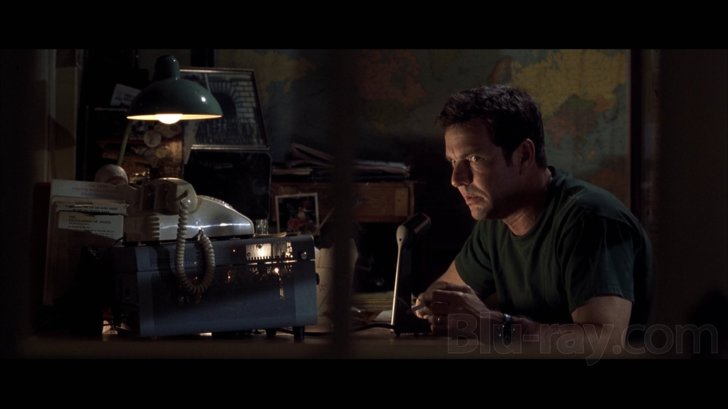
The notion of fixing or perfecting the past ("if only I'd turned this way instead of that") will always exert a powerful hold on the imagination, simply because no life will ever be free from regret or doubt about what might have been. This is one of the potent elements in Frequency's mix, but what gives the film its enduring appeal is the basic desire to see a family healed and made whole again, especially when they begin the story with the warmth that Dennis Quaid and Elizabeth Mitchell lend to the Sullivans. There are few motivations of equal power in storytelling, and Hoblit lets it flow into all of the film's tributaries before they recombine into a mighty river rushing toward the film's conclusion. It's a narrative tour de force that's been capably transferred to Blu-ray. Highly recommended.
Similar titles
Similar titles you might also like

Runaway Jury
2003

The Life of David Gale
2003

Match Point
2005

A Perfect Murder
1998

Kiss the Girls
1997

Secret in Their Eyes
2015

Consenting Adults
1992

Conspiracy Theory
1997

Domestic Disturbance
2001

Same Kind of Different as Me
2017

S.O.S. Tidal Wave
1939

Silent Fall
1994

Lonely Hearts
2006

High Crimes
2002

Twisted
2004

Along Came a Spider
2001

The Ledge
2011

The X-Files: I Want to Believe
2008

Changing Lanes 4K
2002

True Story
2015
